We get behind the wheel of the homologation specials that took rally to new heights.
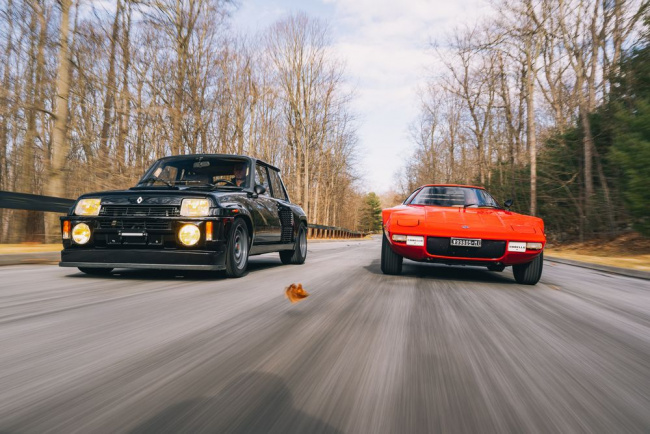
DW Burnett
Modern rally, and therefore, the advent of the rally homologation special, began in the Seventies. It was in 1973 when the FIA formed the World Rally Championship, a singular series where manufacturers, teams, and drivers could test themselves against each other on a global stage. This was when standards were set, and the cars that competed then established the blueprint for all-road performance for decades to come.
Carmakers from around the planet were quick to throw their hats into the ring, with one taking the championship by storm: Lancia. Its front-drive Fulvias had seen some success in regional events, in part leading the Italian firm to create the most iconic two-wheel-drive rally car of all time to compete in the WRC, the Stratos HF.
Penned by Marcello Gandini, who worked at Bertone at the time, the Lancia Stratos HF is a tube-frame, mid-engine two-seater that takes Seventies wedge design to its most extreme. Paper-thin fiberglass clamshell body panels mean an impossibly light curb weight of under 2200 pounds, while a 270-hp V-6 taken from the Ferrari Dino resulted in some serious straightline pace.

DW Burnett
Lancia immediately began winning races with the Stratos following its homologation for the 1974 season. Italian drivers Sandro Munari and Mario Mannucci took back-to-back wins at Rally Sanremo and Rally of the Rideau Lakes, along with a third place finish at the Lombard RAC Rally. A win by French driver Jean-Claude Andruet at Tour de Corse in France behind the wheel of a Stratos would solidify Lancia’s first place finish in the manufacturer’s championship.
The Stratos would continue to dominate. It won the WRC championship the following two years, including two 1-2-3 podium sweeps at Monte Carlo and Sanremo in 1976. By the late Seventies cars like the Fiat 131 and Ford Escort RS 1800 were beginning to catch up and surpass the wedge-shaped Lancia, leading to the company to stop its factory program with the car at the end of the 1978 season. That didn’t stop privateers from continuing to enter—and win—in top level WRC events into the early Eighties, a testament to just how good the platform was.
Lancia promised to build 500 road-going Stratos HFs to satisfy homologation rules for the WRC’s Group 4 class, though it’s estimated just 492 examples left the factory between 1973 and 1975. The car you see here, painted in Red-Orange over a “Havana” Alcantara interior, is one of those cars. Conforming with homologation rulesets, it has the same chassis design, body panels, and drivetrain as the full-on WRC version, albeit slightly detuned to about 180 hp for better street manners.

DW Burnett
Seeing the Stratos in person gives you a good understanding of this car’s proportions. This car is small, shorter yet wider than a first-generation Miata. The sharp nose, tight greenhouse, afterburner-esqe tail lights, and canopy-like windshield give off fighter jet vibes in a package no bigger than a kei van. There’s little room inside, with the upper edge of the windshield sitting just inches from your forehead. The door panels, which double as spaces for drivers to put their helmets, do provide ample elbow room, however.
Believe it or not, this isn’t my first experience with a Stratos HF. I was lucky enough to spend some time riding in the right seat with an acquaintance while leaving a concours event back in 2016. While I never actually got behind the wheel, my stint as a passenger led me to believe the Stratos was unstable, tough to drive, and in some situations, downright sketchy.

Thankfully, this Stratos was nothing like the one I rode in all those years ago. Despite the exotic Italian drivetrain and the car’s sheer age, the driving experience was exceedingly fun, without giving off any of the scary or intimidating vibes I suspected it might. This one was sorted.
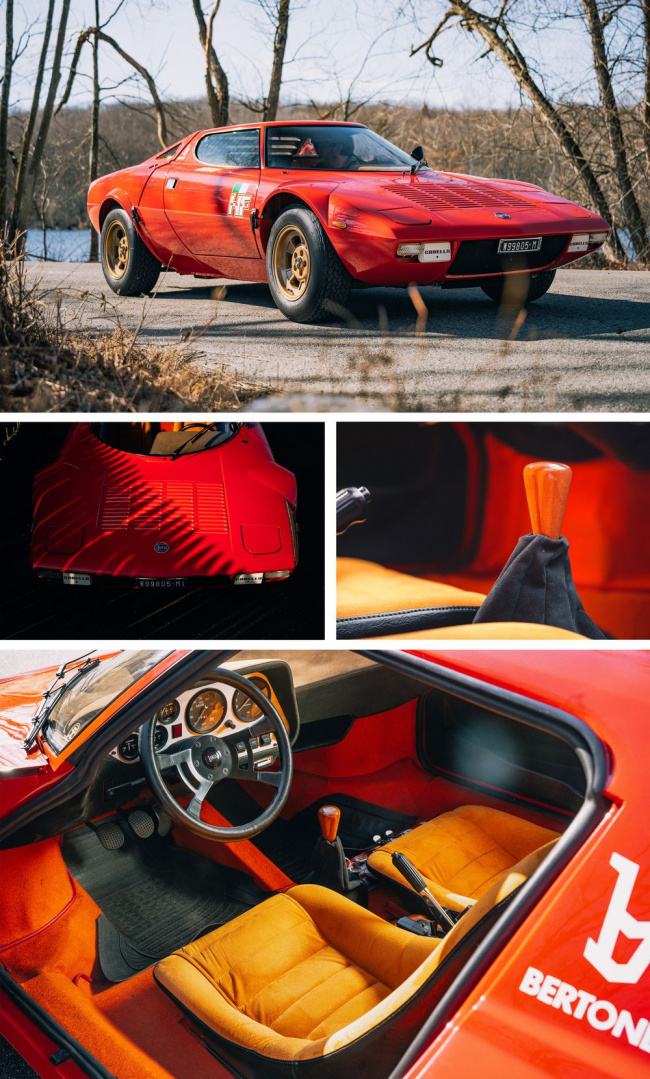
DW Burnett
Aside from the closeness of my head to the windshield, the empty tub in each door card, and the comically narrow seats, there isn’t anything major that stands out once you sit inside. You sit low in the car, and the steering wheel is close by, right where you want it to be. The shifting action from the dogleg five-speed transmission feels natural and well weighted, as does the pedal box. The only “trick” you have to remember with this particular Stratos is to blip the throttle as you’re turning over the starter to get the engine to fire. And it fires without fail, every time.
Otherwise, the Stratos HF operates much like a normal car. The steering and brakes are unassisted, but because the car is so light, you barely notice. Shifting into first or reverse is simple and straightforward, but be sure not to rush the 1-2 shift. Once you adjust your brain to the extra-heavy throttle pedal, it’s not hard to drive the Stratos in modern traffic.
Get it onto a twister bit of tarmac, though, and you need to be paying attention. The mid-engine design and short wheelbase means the Stratos is best piloted through a combination of light steering input and precise throttle control. Take your foot off the gas, and the front tucks in more than you think it will. A well-tuned suspension means the Stratos is never nervous or scary; it’s more like a dancer partner that wants you to take full control. Factor in the all-consuming volume of induction noise, filling the tiny cabin like a wave, and you have yourself a Seventies icon that backs up its stunning looks with an equally rewarding drive.

DW Burnett
Despite the Stratos’s relative approachability, it does, at times, feel extremely delicate. No sound-deadening means you hear every bump or creak in the hand-built frame, and one look at the thin fiberglass shell helps you understand why there are so many in-period photos of Stratos rally cars with missing body panels. There’s just not much to this car, a big reason why it was so successful. And why it should be treated with respect.
Renault’s first serious dive into the WRC wouldn’t come until the tail end of Group 4’s dominance. Its mid-engine A110 predated the formation of the WRC itself and had an awkward carryover period until it stopped production in 1977. Only then did the French automaker create a new racer to compete on the world stage. The resulting car, the Renault 5 Turbo, was a heavily reworked version of the company’s low-cost hatchback, converted to a mid-engine layout sending power to the rear wheels. It’s a bizarre mix on the face of things but makes sense from a practical standpoint. On the back of the A110, Renault knew how to make rally cars with the engine behind the driver. Renault also knew that racing is marketing; it doesn’t do you any good to promote a low-volume sports car when you could be championing your most high-volume hatchback instead. To reconcile the two ideas, just rip out your economy car’s back seats and throw an engine in there.
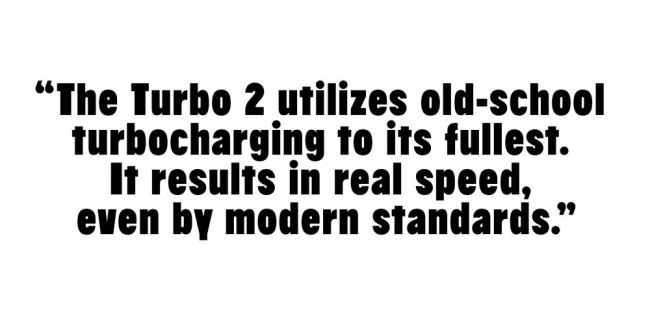
The original Turbo’s 265 hp and impressively low sub 2000-pound curb weight meant it had good chances against other Group 4 cars when it debuted at Tour de Corse in 1980. But it stood woefully outclassed against the emerging all-wheel-drive giants at Audi. It wouldn’t help that Renault was selective about which WRC events it competed in, as its rally team was essentially an afterthought compared to the company’s Formula 1 efforts at the time. (Renault pioneered turbocharging in F1, entering the first boosted car in the championship starting in 1977.)
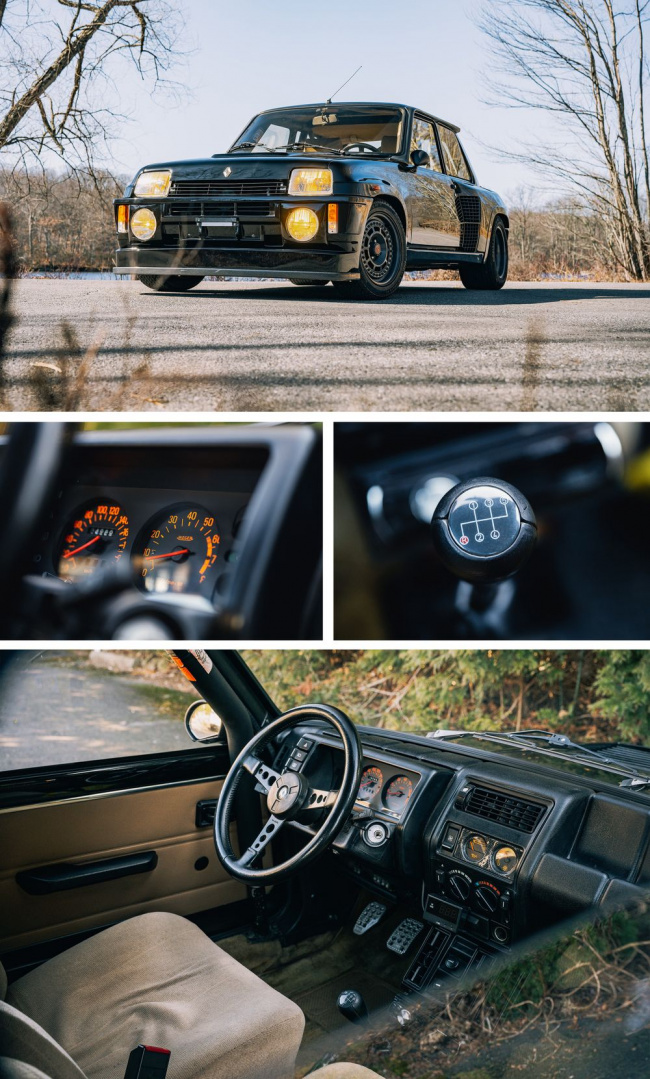
DW Burnett
Still, the 5 Turbo did snag a handful of victories during its time at the top level of rally. Its first came in 1981 at Monte Carlo at the hands of drivers Jean Ragnotti and Jean-Marc Andrié, though it was more of a lucky break, as the leading Quattro, which made its debut at the same race, broke down. The Turbo would take a few more one-off wins at Tour de Course and Rally de Portugal throughout the Eighties, but without AWD it could never achieve true greatness. By 1983 Audis and Lancia 037s would be sweeping virtually every podium position in the championship.
The Renault 5 Turbo 2 you see here isn’t one of the 445 original road-going versions built to homologate the rally car for Group 4. Unlike other Turbo 2s, it is not a lower-cost version released in 1983 designed to capitalize on the first car’s popularity. Instead it’s yet-rarer Type 8221, one of 200 cars built to homologate the vehicle to the then-new Group B specification. Normally the Turbo 2 had to make do with steel versions from the standard Renault 5, known in America as the Le Car. This one got lightweight aluminum panels for the doors, roof, and hatch for homologation purposes. And while the original Turbo got a unique dashboard and instrumentation, the Turbo 2 received a more pedestrian cabin setup, also from the front-drive Renault 5.
Thankfully Renault did nothing to dull the longitudinally mounted 1.4-liter turbocharged powertrain in the switch from Turbo to Turbo 2. The outrageous bodywork, needed to cover the extra-wide track caused by the scarcely-believable 285/40-15 section width rear tires, was also retained. But a lower price point meant broader appeal for a wider audience. Renault managed to sell over 5000 Turbo 2s over roughly three years of production—surprising given its odd design, lack of practicality, and reputation for snap oversteer. A handful were even sold in America as gray-market imports through a company called Sun International.
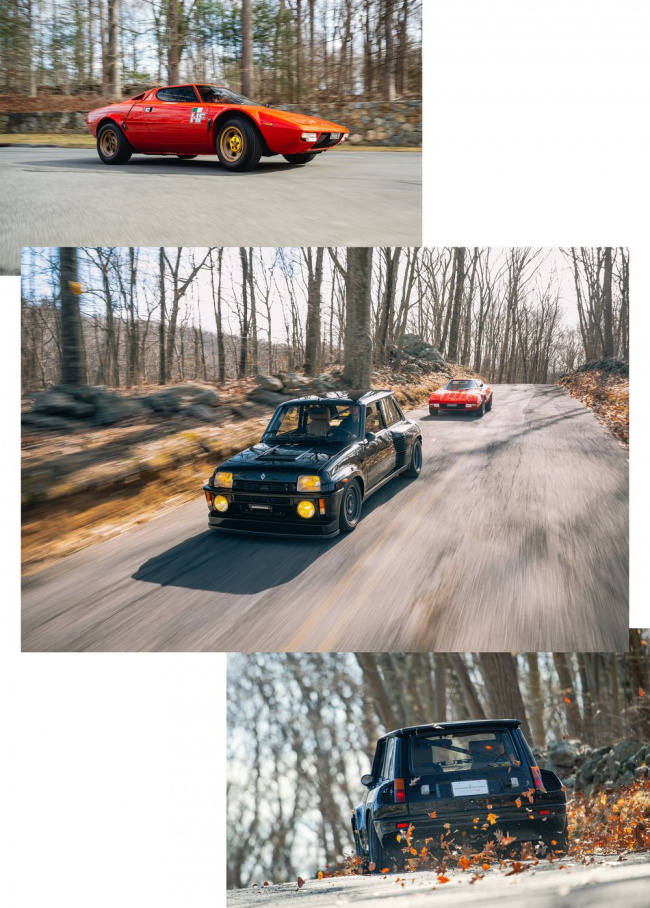
DW Burnett
The Turbo 2’s looks are more quirky than elegant, a vast contrast when placed aside the space-age Stratos. It too takes up a small footprint, though those rear haunches and squared off bodylines make it easy to admire for hours on end. Cool and weird? Definitely. But pretty, the Turbo 2 is not.
Behind the wheel, the Turbo 2 and the Stratos are polar opposites. The Renault feels less like a museum piece and more like a commuter, unable to escape its econobox origins. There’s a normalcy that leads you to believe you could easily use this car as a daily driver without any compromise to comfort. There’s real sound deadening and a reasonable amount of suspension travel. The five-speed shifter is easy to use and buttery smooth. Stay out of boost, and the engine is a pleasant thing that takes a back seat (literally) to the experience.
The generational gap feels even wider once you bury your foot into the throttle. Whereas the Stratos and its Ferrari V-6 generate a smooth, linear power delivery, the Turbo 2 utilizes old-school turbocharging to its fullest. This is one of the very first turbocharged production cars, period. That means virtually nothing under 4000 rpm followed by a fat slug of torque once the turbo kicks in. It’s addictive fun and, because the Renault has low mass, results in real speed, even by modern standards. While it can’t match the sound of the Lancia, the pops and bangs from the exhaust are just as giggle-inducing.

DW Burnett
The view from the driver’s seat is that of a normal Renault 5, with all of the same creature comforts. That means a real climate control system and plenty of storage solutions. You sit upright and far from the steering wheel, making for an awkward seating position that, at least in my case, had my arms almost fully extended to operate the manual steering rack.
Turning that rack takes more effort than I expected it would, in part due to how my arms were positioned. It’s the one piece of feedback from the Turbo 2 that reminds you this is no ordinary hatch. I didn’t get to push the car too hard, so I can’t exactly speak on the car’s tendency to catch drivers off-guard with its infamous weight transfer. In fact, the Turbo 2 here felt sufficiently docile, even at high speeds. Next time we’ll use a closed course to get to the bottom of things.
Now is also a good time to note that these cars were graciously lent to us by the Cultivated Collector in New Canaan, CT, and both are for sale. Find them here and here.
Both of these cars mark the beginning of the homologation golden age. The Stratos, with its unforgettable styling and dominant string of rally championships, launched Lancia into the mainstream, cementing the brand as a long-standing Italian legend even after decades of modern irrelevancy. While the mid-engine Renault 5 Turbo wasn’t as successful in its original intent, its road-going counterpart was a commercial win that retained a cult following, leading to a modern revival in the form of the Clio V6. Renault is still dipping into the Turbo’s popularity to this day; in 2022 it released an all-electric variant to promote its future drivetrain tech. Proof these cars will remain at the forefront of automotive culture for years to come.
Brian Silvestro Road & Track staff writer with a taste for high-mileage, rusted-out projects and amateur endurance racing.
Keyword: Driving the Lancia Stratos and the Renault 5 Turbo II: Group 4 Legends
